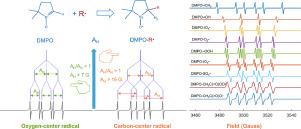Water Research ( IF 12.8 ) Pub Date : 2022-06-15 , DOI: 10.1016/j.watres.2022.118747 Long Chen 1 , Jun Duan 1 , Penghui Du 2 , Weiliang Sun 3 , Bo Lai 4 , Wen Liu 1

|
Accurate identification of radicals in advanced oxidation processes (AOPs) is important to study the mechanisms on radical production and subsequent oxidation-reduction reaction. The commonly applied radical quenching experiments cannot provide direct evidences on generation and evolution of radicals in AOPs, while electron paramagnetic resonance (EPR) is a cutting-edge technology to identify radicals based on spectral characteristics. However, the complexity of EPR spectrum brings uncertainty and inconsistency to radical identification and mechanism clarification. This work presented a comprehensive study on identification of radicals by in-situ EPR analysis in four typical UV-based homogenous AOPs, including UV/H2O2, UV/peroxodisulfate (and peroxymonosulfate), UV/peracetic acid and UV/IO4− systems. Radical formation mechanism was also clarified based on EPR results. A reliable EPR method using organic solvents was proposed to identify alkoxy and alkyl radicals (CH3C(=O)OO·, CH3C(=O)O· and ·CH3) in UV/PAA system. Two activation pathways for radical production were proposed in UV/IO4− system, in which the produced IO3·, IO4·, ·OH and hydrated electron were precisely detected. It is interesting that addition of specific organic solvents can effectively identify oxygen-center and carbon-center radicals. A key parameter in EPR spectrum for 5,5-dimethyl-1-pyrroline N-oxide (DMPO) spin adduct, AH, is ranked as: ·CH3 (23 G) >·OH (15 G) >IO3· (12.9 G) >O2·− (11 G) ≥·OOH (9–11 G) ≥IO4· (9–10 G) ≥SO4·− (9–10 G) >CH3C(=O)OO· (8.5 G) > CH3C(=O)O· (7.5 G). This study will give a systematic method on identification of radicals in AOPs, and shed light on the insightful understanding of radical production mechanism.
中文翻译:

紫外均相高级氧化过程中通过原位电子顺磁共振准确识别自由基
准确识别高级氧化过程(AOPs)中的自由基对于研究自由基产生和随后的氧化还原反应的机制非常重要。常用的自由基猝灭实验不能直接证明AOPs中自由基的产生和演化,而电子顺磁共振(EPR)是一种基于光谱特征识别自由基的前沿技术。然而,EPR谱的复杂性给激进的识别和机制澄清带来了不确定性和不一致。这项工作通过原位 EPR 分析对四种典型的基于 UV 的均质 AOP 中自由基的鉴定进行了全面研究,包括 UV/H 2 O 2、UV/过氧二硫酸盐(和过氧单硫酸盐)、UV/过乙酸和UV/IO 4 -系统。基于 EPR 结果也阐明了自由基的形成机制。提出了一种可靠的有机溶剂EPR方法来鉴定UV/PAA体系中的烷氧基和烷基自由基(CH 3 C(=O)OO·、CH 3 C(=O)O·和·CH 3 )。在 UV/IO 4 -系统中提出了两种自由基产生的活化途径,其中产生的 IO 3 ·、IO 4·、·OH和水合电子被精确检测。有趣的是,添加特定的有机溶剂可以有效地识别氧中心和碳中心自由基。5,5-二甲基-1-吡咯啉 N-氧化物 (DMPO) 自旋加合物 A H的 EPR 光谱中的一个关键参数排名为:·CH 3 (23 G) >·OH (15 G) >IO 3 · (12.9 G) >O 2 · - (11 G) ≥·OOH (9-11 G) ≥IO 4 · (9-10 G) ≥SO 4 · - (9-10 G) >CH 3 C(=O )OO· (8.5 G) > CH 3C(=O)O·(7.5G)。本研究将为AOPs中自由基的鉴定提供系统的方法,并有助于深入理解自由基的产生机制。



























 京公网安备 11010802027423号
京公网安备 11010802027423号